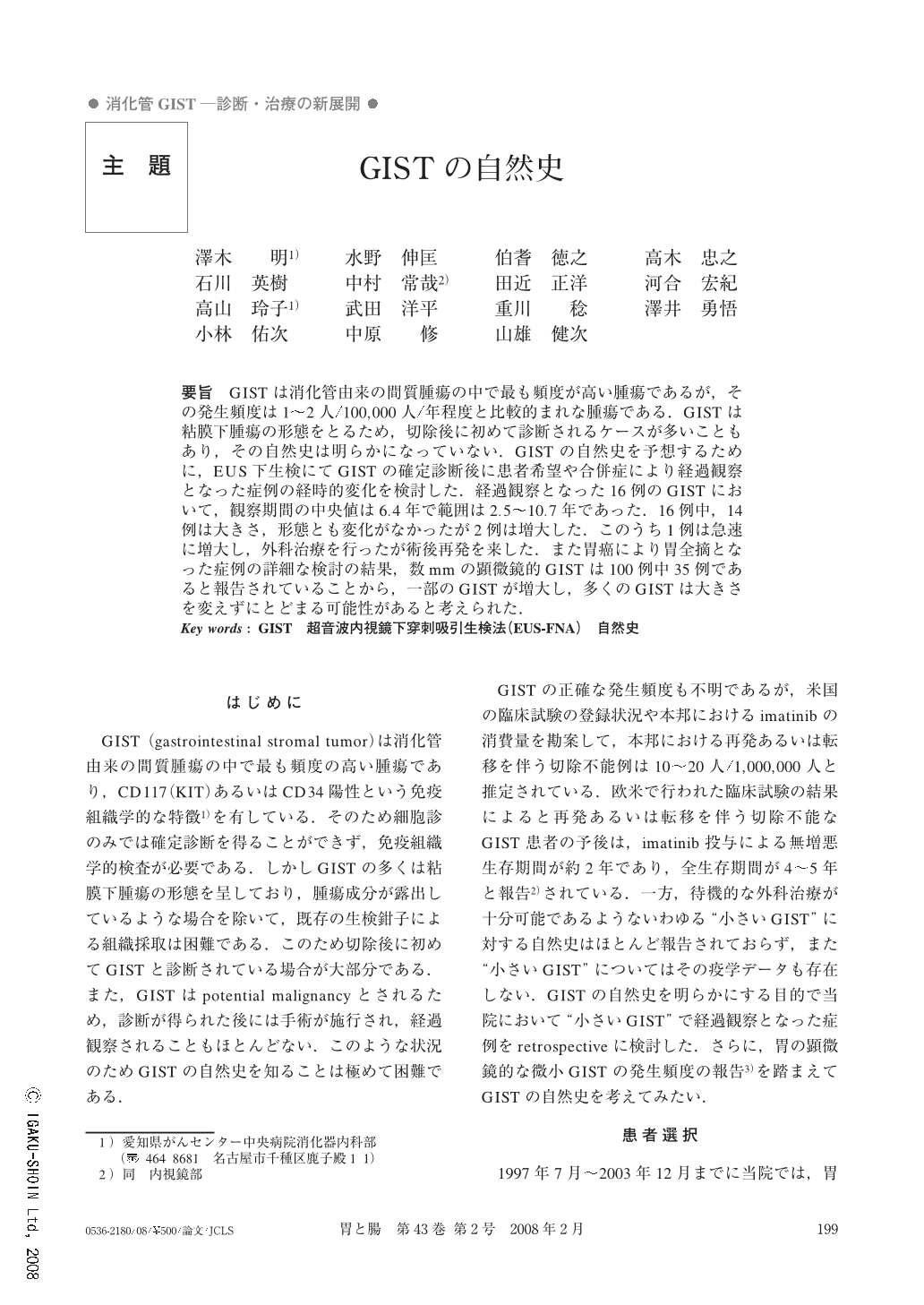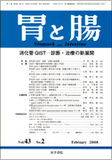Japanese
English
- 有料閲覧
- Abstract 文献概要
- 1ページ目 Look Inside
- 参考文献 Reference
- サイト内被引用 Cited by
要旨 GISTは消化管由来の間質腫瘍の中で最も頻度が高い腫瘍であるが,その発生頻度は1~2人/100,000人/年程度と比較的まれな腫瘍である.GISTは粘膜下腫瘍の形態をとるため,切除後に初めて診断されるケースが多いこともあり,その自然史は明らかになっていない.GISTの自然史を予想するために,EUS下生検にてGISTの確定診断後に患者希望や合併症により経過観察となった症例の経時的変化を検討した.経過観察となった16例のGISTにおいて,観察期間の中央値は6.4年で範囲は2.5~10.7年であった.16例中,14例は大きさ,形態とも変化がなかったが2例は増大した.このうち1例は急速に増大し,外科治療を行ったが術後再発を来した.また胃癌により胃全摘となった症例の詳細な検討の結果,数mmの顕微鏡的GISTは100例中35例であると報告されていることから,一部のGISTが増大し,多くのGISTは大きさを変えずにとどまる可能性があると考えられた.
Gastrointestinal stromal tumors (GISTs) are rare mesenchymal neoplasms with an annual incidence of approximately 10 to 20 per 1 million cases. Although pathologists have often observed incidental small GISTs in the stomach resected from patients with gastric cancer, no report on the real incidence of gastric GISTs is available. In this study, 100 whole stomachs resected from patients with gastric cancer were sectioned at 5 mm intervals and hematoxylin and eosin-stained slides (a mean of 130 slides for each case) were examined for microscopic GISTs. KIT (CD117), CD34, and desmin expression of the incidental tumors was evaluated by immunohistochemistry, and genomic DNA extracted from formalin-fixed and paraffin-embedded tumor tissues was analyzed for c-kit gene mutations in exon 11. In 35 of the 100 whole stomachs, we found 50 microscopic GISTs, all of which were positive for KIT and/or CD34 and negative for desmin. Most microscopic GISTs (45/50, 90%) were located in the upper stomach. Two of the 25 (8%) microscopic GISTs had c-kit gene mutations. Fifty-one leiomyomas with positive expression for desmin were observed in 28 of the 100 stomachs. Both leiomyomas and GISTs were found in 12 stomachs. These results indicate that microscopic GISTs are common in the upper portion of the stomach. Considering the annual incidence of clinical GISTs, only few microscopic GISTs may develop to a clinical size with malignant potential. Further studies are required to clarify the genetic events responsible for the transformation of microscopic GISTs to clinical GISTs.
Although gastrointestinal stromal tumors (GISTs) are one of the most common mesenchymal tumors of the gastrointestinal tract, their annual incidence is approximately estimated at only 10 to 20 per 1 million cases. The natural history of GISTs hasn't been clear because the preoperative pathology assessment is thought to be difficult to confirm because the diagnosis using the core needle biopsy essential for doing it is needed after removal of any suspected GIST. To discuss the natural history, we investigated the changes in size and configuration of small GISTs that were pathologically confirmed using endoscopic ultrasonography-guided fine-needle aspiration biopsy (EUS-FNA). Between July, 1997 and December, 2005, 16 tumors in 16 patients (10 men and 6 women) with an immunohistochemical diagnosis of GIST were regularly followed up in our hospital. The median patient age at EUS-FNA was 62 years (range 26~82) and the median follow-up period was 6.4 years (range 2.5~10.7 years). Compared to the initial diagnosis, fourteen tumors showed no remarkable changes in size or shape during follow-up. Two tumors were enlarged:one tumor approximately doubled its diameter in 8 years and the other tumor increased from 1.8 cm to 10 cm after only 2 years. Although surgical removal was performed for the latter rapid progression case, it was recurrent and death due to GIST followed. Kawamowa et al reported that microscopic GISTs were found in 35 of the 100 stomachs resected from patients with gastric cancer. Some microscopic GISTs may develop to a clinical size with a higher malignant potential, but the others may remain for a long time.

Copyright © 2008, Igaku-Shoin Ltd. All rights reserved.


